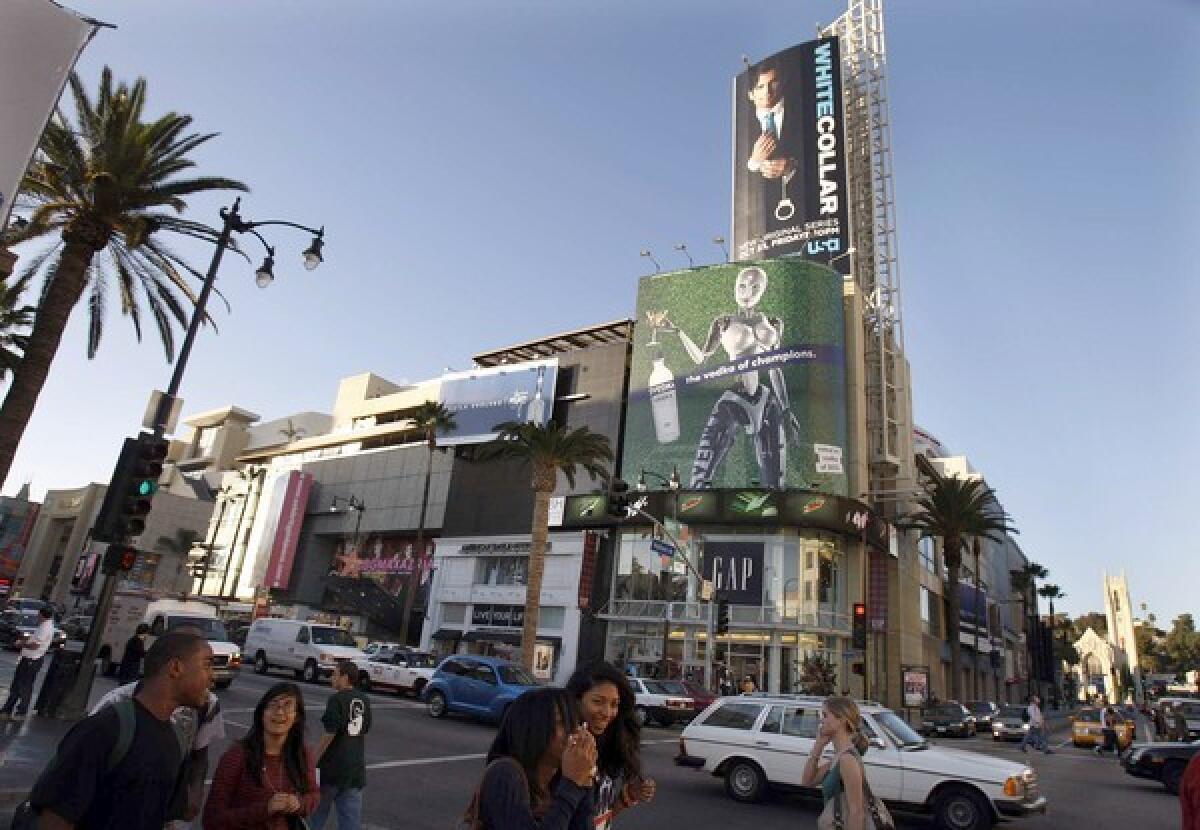CIM lands in pension-fund spotlight

- Share via
Real estate developer CIM Group Inc. has built a reputation as a big-city turnaround artist, transforming dreary business districts from downtown Los Angeles to Washington, D.C., with pricey loft apartments, trendy retailers and leafy pedestrian malls.
Founded in 1994 by two Israeli immigrants and an investment banker who once worked with junk-bond king Michael Milken, CIM has made its mark on some of the more recognizable developments in Southern California, including Santa Monica’s Third Street Promenade.
Along the way, Hollywood-based CIM has secured billions of dollars in pension fund investments and tens of millions of dollars in public subsidies -- chiefly by locating many of its projects in struggling neighborhoods where grants, loans and other forms of taxpayer help were readily available.
In recent weeks, its voracious appetite for public investment landed CIM in the public spotlight.
Recently released documents show that CIM paid former Los Angeles Deputy Mayor Alfred J.R. Villalobos nearly $16 million in fees for securing investments from the California Public Employees’ Retirement System and the California State Teachers’ Retirement System.
CIM has not been accused of any wrongdoing, but CalPERS officials said they were unaware of the amounts CIM and others had paid to Villalobos and other so-called placement agents, who lobby pension funds on behalf of big money managers. CalPERS officials have also hired an outside law firm to determine whether the fees and investments were proper.
CalPERS has a $466-million balance in a CIM fund initially pitched by Villalobos, and over the last decade has agreed to invest nearly $1.9 billion with the company.
In Los Angeles, meanwhile, the Securities and Exchange Commission has asked former Fire and Police Pensions board member Elliott Broidy to disclose his communications with CIM and other firms, according to court documents.
Broidy pleaded guilty Dec. 3 to a felony corruption charge in New York, admitting that he paid $1 million in gifts to public pension officials there to win $250 million in investment capital for his private equity fund.
While on the Los Angeles board, Broidy voted in 2007 to invest $30 million in CIM. At that time, CIM had $500,000 invested in Markstone Capital Partners, a fund that Broidy managed. CIM said the investment was personally staked by the company’s principals, not pension money.
Fire and Police Pensions board President George Aliano said he was not aware of the relationship between Broidy and CIM until recently, and criticized CIM for not disclosing it. “For me, it will be difficult to invest in them” in the future, Aliano said.
Executives at the company, which employs 200 workers, declined to be interviewed for this article but answered some questions in writing.
In a statement, CIM said it had provided state pension officials “ample disclosures concerning its use of placement agents” such as Villalobos and did not want to distract from the ongoing investigations.
The company did not address Aliano’s complaints, but said it had been “a pioneer in the adaptive reuse of California downtown real estate to meet the demands of a nationwide trend toward urban living.”
CIM’s growing list of projects and properties includes the Ralphs supermarket in downtown Los Angeles, the Lady Luck Hotel & Casino in Las Vegas and downtown renewal projects from Anaheim to San Jose.
“They were in the Hollywood market before most of the players went there. They were in Santa Monica before the Third Street Promenade took off. They have been ahead of the curve,” said Bob Safai, a commercial real estate broker with Madison Partners.
CIM’s founders first met by chance in 1987 when two friends from Israel -- Shaul Kuba and Avi Shemesh -- showed up at the home of Richard Ressler to talk about landscaping his property.
Shemesh and Kuba both grew up in Herzliya, a city outside Tel Aviv. They served in the same brigade of the Israeli army and arrived in the United States at the same time. By the 1980s, Shemesh had a landscaping and contracting company and Kuba had an electrical business.
Ressler, who holds a law degree and MBA from Columbia University, had spent part of that decade handling mergers and acquisitions for Drexel Burnham Lambert, the firm made famous by Milken.
The three men formed CIM in 1994, adopting a three-letter name that “does not stand for anything in particular,” the company said. That year, CIM began acquiring properties in Santa Monica, where city officials were trying to revitalize a dormant pedestrian mall just a few blocks from the ocean.
By 1997, CIM owned a handful of buildings on or near the Third Street Promenade. The buildings now house retailers such as J. Crew and Banana Republic.
Those acquisitions helped drive the transformation of the pedestrian-oriented district from a series of vacant storefronts into a bustling entertainment strip, said Dan Weinstein, a placement agent who has pitched CIM funds to pension officials in California, New Mexico and Texas.
“They went in there and made a bet on Third Street Promenade,” said Weinstein, a managing partner with Wetherly Capital Group. “And Third Street Promenade went on to set the tone for the rebirth of outdoor shopping.”
CIM broadened its reach by the end of the 1990s to include Brea, where city leaders also were looking to remake a sleepy downtown. The company developed nearly 200,000 square feet of retail space while incorporating loft apartments and chain restaurants, a formula it would replicate in other business districts and redevelopment zones.
Brea’s redevelopment agency used the power of eminent domain to forcibly acquire much of the land, then sold it below market value to CIM. The city also paid CIM to build restrooms, parking and sidewalks, improvements that made CIM’s buildings more valuable when it sold them a few years later.
Looking to finance an expanding list of projects, CIM began courting big-money investors such as CalPERS and the California State Teachers’ Retirement System. It hired Villalobos, who had previously served as a CalPERS board member, to pitch its fund to state pension officials.
As the real estate market continued its climb, pension agencies across the nation followed CalPERS’ lead, committing hundreds of millions of dollars to CIM’s Real Estate Investment Trust and CIM Fund III, both of which focused on the acquisition of urban properties.
While retirement systems in New York, Texas and Arizona allocated hundreds of millions of dollars to CIM funds, cities such as Sacramento, Anaheim and San Jose provided various forms of financial help to the company’s development projects.
CIM was especially successful in Los Angeles, where officials have offered at least $58 million in loans and grants. The most recent: a $30-million federal loan to help CIM attract Cirque du Soleil to the Kodak Theatre at the Hollywood & Highland shopping center.
Taxpayer subsidies helped CIM deliver double-digit returns to its investors for much of the decade. The company, however, said such financial help comprised only 2% of the billions of dollars it has invested so far. It would not provide a dollar value for that help or say how many deals are pending.
“The vast majority of CIM’s investments have not required or used agency or any form of public financial incentives,” the company said.
Several CIM projects have been delayed -- some indefinitely -- following the collapse of the nation’s real estate and credit markets. Yet even before the downturn, CIM had begun turning to other sectors for profits, including the energy and water sectors.
In 2007, the company persuaded CalPERS to invest up to $200 million in a CIM Infrastructure Fund, which placed an emphasis on renewable energy such as wind, solar and geothermal power.
A year later, a joint venture of CIM and Renewable Resources Group -- a firm headed by Ari Swiller, a friend of and fundraiser for L.A. Mayor Antonio Villaraigosa -- bought 48,000 acres of land in Kern County that had been sought by the Los Angeles Department of Water and Power for wind farm development.
Days after it purchased the land for $48 million, the venture sold less than half of it to the city of Vernon for $42 million.
While other real estate firms have seen their private-sector financing dry up, CIM has been able to rely on public pension systems such as CalPERS. Those financial ties can only help CIM, said Harry Mavrogenes, executive director of San Jose’s redevelopment agency.
“They’ve done a credible job of delivering the projects in a tough environment,” he said. “The real estate market isn’t what it was, and they delivered on the projects they were supposed to.”
Staff writer Marc Lifsher contributed to this report.
More to Read
Inside the business of entertainment
The Wide Shot brings you news, analysis and insights on everything from streaming wars to production — and what it all means for the future.
You may occasionally receive promotional content from the Los Angeles Times.












